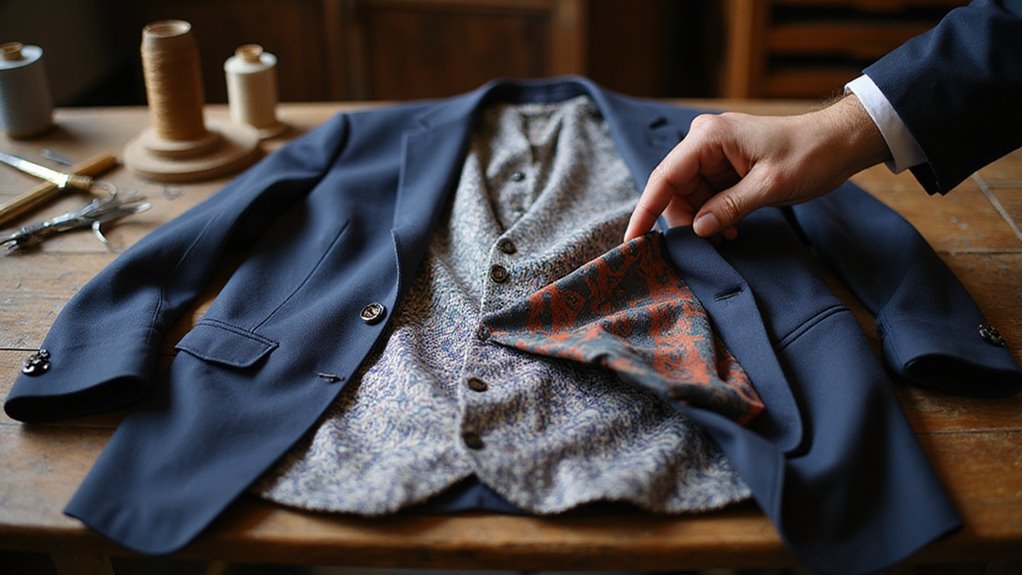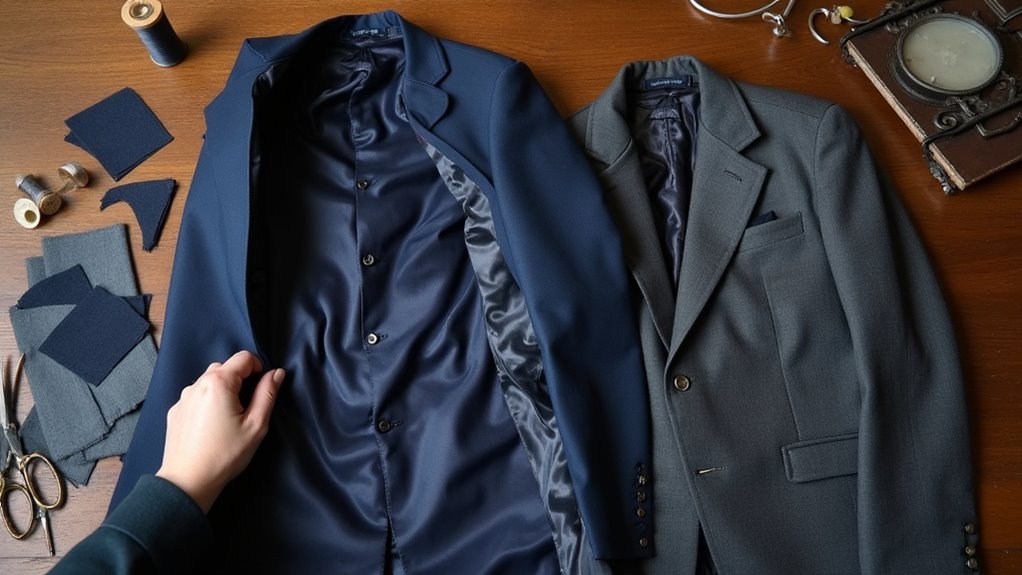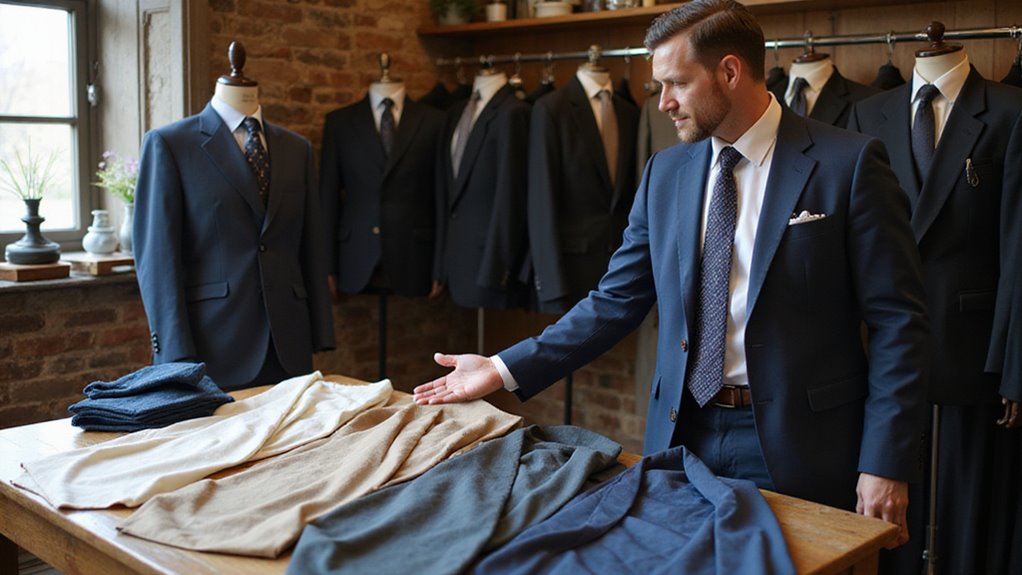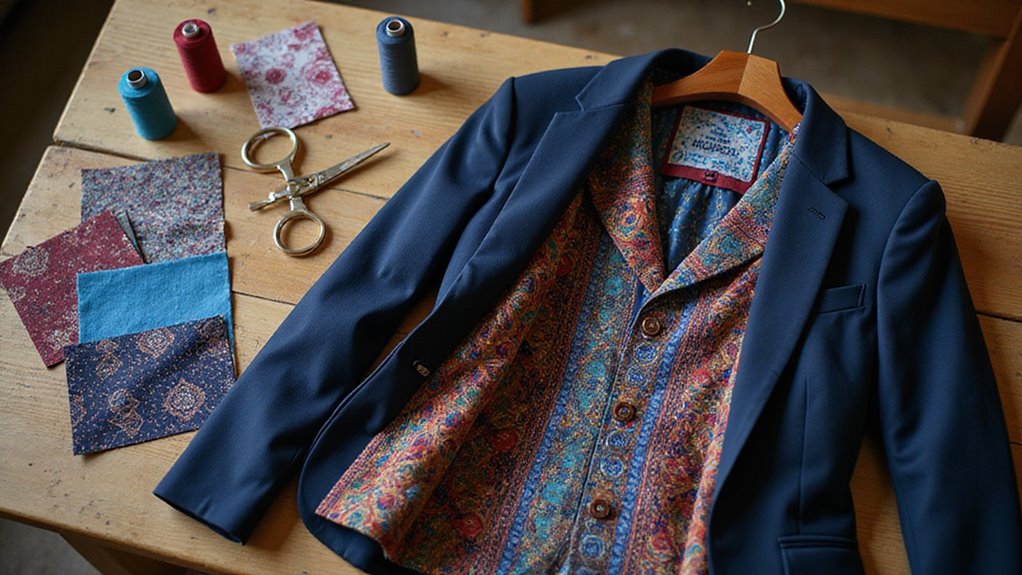Choosing the right lining for your custom suit jacket can be tricky. Many options exist, but not all work for every suit. The wrong lining can look cheap or feel uncomfortable, even if the fabric is expensive and the fit is perfect.
A poor choice can make you sweat, restrict movement, or wear out quickly. These problems can ruin your confidence and shorten your jacket’s life. You want a suit that feels as good as it looks, inside and out.
The best way to choose a lining for your custom suit jacket is to balance comfort, durability, and style. This means knowing your options and matching them to your needs and taste.
The right lining makes your suit feel special every time you wear it. This blog will guide you through the process so you get the perfect lining for your custom suit.
Key Takeaways
- Select a lining material—such as Bemberg, silk, or viscose—based on comfort, breathability, and desired durability for your climate and daily use.
- Match the lining color and pattern to your jacket’s style, opting for subtle tones for formality or bold prints for personal flair.
- Ensure the lining’s weight and thickness complement the outer fabric and suit the intended season for optimal comfort and wearability.
- Prioritize quality and construction details like reinforced seams and fabric strength to enhance jacket longevity and maintain its shape.
- Consider maintenance needs, choosing a lining that fits your cleaning routine and offers resistance to wear, stains, and shrinkage.
Understanding the Purpose of Jacket Linings

A jacket lining has important jobs beyond looks. It helps the jacket fit better and makes it easier to put on. The lining covers inside seams, giving a neat finish. If the lining fabric is dyed poorly, its color may bleed and stain the outer fabric. A well-fitted lining is important, because a bad fit can make the jacket lose its shape. The lining helps control moisture and temperature, making the jacket more comfortable.
Choosing the right lining is especially important when considering the differences between a sport coat, blazer, and suit coat, since each jacket type has distinct fabric and structural needs. If you want a durable and comfortable jacket, you should choose the lining carefully. Suit linings can be customized for different styles, textures, and fits, allowing you to match specific project requirements and enhance both comfort and visual appeal.
Exploring Common Lining Fabrics
Common jacket lining fabrics affect comfort, look, and durability. Bemberg is a soft, breathable fabric that feels smooth and glides easily. Silk feels luxurious and drapes well, making it ideal for formal jackets. Polyester and acetate are both affordable and light, but may not last as long or breathe as well. Viscose is soft and manages moisture better than polyester. If you want a unique style, you can pick bright or patterned linings.
The lining you choose can also influence how your jacket feels during wear, just as the level of customization found in bespoke or tailored suits impacts overall comfort and fit. Choosing the right fabric and color will shape your jacket’s comfort and style. Many designers use digital model mockups to visualize how different lining fabrics and colors will appear inside a jacket before finalizing their choice.
Weighing Natural vs. Synthetic Materials

Natural and synthetic materials have different qualities. Natural linings, like silk or Bemberg, feel soft and drape well. They look elegant and help prevent static cling. If you want luxury and comfort, consider natural linings. Synthetic linings, such as polyester or acetate, resist wear and keep their color well. These are usually less expensive but can feel stiff and look shiny. If you want something durable and affordable, choose synthetic linings.
You should pick a lining based on how you want your jacket to look, feel, and last. When selecting a lining, it’s also important to consider how the fabric weave can add texture and depth to both the exterior and interior of your custom suit. The choice of lining also reflects the evolution of suit style, as modern suit design incorporates both traditional and innovative materials for greater versatility and comfort.
Assessing Breathability and Comfort
A suit jacket’s lining affects how comfortable and breathable it feels. Choose a lining that lets air flow and keeps you cool. Good options include Bemberg, silk, and cupro, which help move sweat away from your skin. These fabrics also allow air to pass through, preventing heat buildup. A finer weave usually means better airflow, while a dense weave can trap heat.
If comfort matters to you, ask your tailor for a breathable lining. Focusing on these details helps you stay comfortable all day. The choice of fabric and weave density in your lining can have a significant impact on your overall comfort and ease of movement throughout the day. For even better results, consider linings that mimic natural, soft lighting to enhance both the look and comfort of your custom suit.
Matching Lining Weight to the Season

The right lining weight keeps your suit comfortable in any season. Lightweight linings like Bemberg or silk work best for warm weather. These linings are usually 50-70 grams per square meter. They help your jacket breathe and prevent excess heat. Heavier linings such as viscose or cupro blends suit colder months. These usually weigh 90-120 grams per square meter and add warmth.
Always match the lining’s weight to the outer fabric’s thickness. If you wear suits often or live in a variable climate, adjust the lining weight to your needs. Choosing the appropriate lining weight not only increases comfort but also extends the longevity of your bespoke suit. This approach ensures your suit stays stylish and practical all year. When selecting a lining, consider how mockup development tools can help you visualize fabric weights and textures before making your final choice.
Considering Durability and Longevity
You’ll want to prioritize fabric strength when selecting a suit jacket lining, as higher tensile fibers resist tearing and stretching. Assess wear resistance factors like abrasion ratings and seam integrity to ensure your lining handles frequent use. Don’t overlook maintenance requirements—some linings demand specialized care, directly impacting your jacket’s longevity.
Since linings made from certain fabrics can experience gradual shrinkage over time, it’s wise to consider how washing and cleaning methods will affect the overall fit and durability of your jacket. Utilizing high-quality mockups can also help you visualize how different lining materials will appear and perform in your finished jacket, supporting a refined and durable final result.
Fabric Strength Matters
Fabric strength is very important for suit jacket linings. Strong linings last longer and keep their shape with regular use. You should check the material’s weave and how tightly it is woven. Fabrics like Bemberg, cupro, or quality polyester blends are usually strong.
If the lining uses reinforced stitching, it will be less likely to tear at seams. A dense fiber structure prevents damage at stress points. If you want a durable jacket, pick a lining with these features. This way, your jacket will look good and last a long time.
Wear Resistance Factors
Wear resistance shows how well a lining can handle daily use. It measures how the fabric stands up to friction and movement. Suit linings face stress from repeated wear and pressure points. If a lining resists abrasion, it will last longer and keep its shape.
Double rub counts and abrasion ratings help you compare materials. Fabrics like Bemberg or quality viscose often show strong wear resistance. If you pick these, your jacket lining is less likely to thin or tear. Good wear resistance keeps the lining looking fresh and protects your investment.
Maintenance and Care
Proper care helps your suit jacket lining last longer. Each type of lining needs different cleaning methods. Silk, Bemberg, and synthetic linings all have unique care needs. If your lining is delicate, take it to a professional dry cleaner.
Always spot clean stains right away using gentle cleaners. Hang your jacket on a wide hanger to keep its shape. You can rotate your jackets to reduce wear on one lining. If you follow these steps, your jacket lining will stay in good condition.
Choosing the Right Lining Color
The right lining color changes how your jacket looks and feels. Classic linings match the outer fabric for a simple look. Bold linings use different colors to make the jacket stand out. Light colors like blue or mint work well for spring and summer. Dark colors like burgundy or green suit fall and winter jackets. Formal jackets look best with neutral linings. Bright linings can show more personality in casual styles.
If you want your jacket to match your clothes, pick a lining in a similar shade. Thoughtful lining choices highlight the jacket’s shape and style. When choosing a lining, consider how your choice can complement the seasonal palette for a more cohesive wardrobe. When selecting your lining, it’s also helpful to consider maintenance & durability to ensure your chosen color and material stay looking great over time.
Playing With Patterns and Prints

Patterns and prints add personality to your jacket lining. These details help your jacket stand out and show individual style. You can choose stripes, geometric shapes, or small paisley patterns. Make sure the pattern fits the look you want.
Here are some tips for picking patterns and prints:
- Large patterns will stand out, while small ones look subtle.
- Patterns that repeat evenly create a neat look.
- High contrast patterns catch the eye, while low contrast looks calm.
- If you mix patterns, choose ones with similar colors and styles.
A good lining choice shows your attention to detail. For designers, experimenting with customizable design elements in mockups can help you visualize how different patterns will look before making a final decision.
Coordinating With Outer Fabric and Suit Style
When choosing a lining, match it with the jacket’s fabric and suit style. The right combination creates a balanced look. Select a lining material that feels good and looks right with the outer fabric. If you use silk with wool flannel, you get a nice contrast.
Always match or blend the lining color with the jacket for a neat look. If you want a formal suit, pick a subtle shine. Choose simple linings for business suits. If you prefer a modern style, try a slight color difference. Use the table below for good fabric and lining pairs:
| Outer Fabric & Texture | Recommended Lining Coordination |
|---|---|
| Worsted Wool | Smooth silk, matching or muted color |
| Tweed | Matte viscose, earth tone |
| Linen | Lightweight cupro, pastel shade |
| Velvet | Glossy satin, deep jewel tone |
| Herringbone | Subtle pattern, complementary color |
Reflecting Personal Style and Personality

The lining of your suit jacket is a way to show your personal style. It is not just a hidden part of the jacket. You can choose colors and patterns that make your jacket unique. If you like bold looks, pick a lining color that stands out from the outer fabric.
Patterns like stripes or paisley can give your jacket a modern touch. You may add initials or symbols with embroidery for a personal detail. Linings can also reflect your hobbies or background if you wish. These options help your suit fit your personality while keeping it well-made.
Factoring in Care and Maintenance
Care and maintenance are important when choosing a lining for your suit. The lining touches your skin, so it needs to be strong and easy to clean. Durable linings, like Bemberg or good silk, resist pilling and tearing. Some linings can be spot cleaned, but others need dry cleaning. This choice affects how your jacket looks and stays clean over time.
Reinforced seams and tight stitching help prevent damage and make repairs easier. If you will wear the suit often, linings with stain or germ protection are helpful. Good fabric and careful sewing lower repair needs and keep your jacket ready to wear. Easy-care linings are best for daily use.
Evaluating Budget Options
Budget is an important factor when choosing a suit lining. You need to weigh cost, comfort, and appearance. If you want to save money, consider these fabrics:
- Polyester: This fabric is cheap and strong. It keeps its color but does not breathe well.
- Viscose (Rayon): Viscose looks and feels like silk. It costs less but is not as tough.
- Acetate: Acetate is smooth and light. It is low-cost but can wear out faster.
- Blended Linings: Blends mix synthetic fibers for better quality at a low price.
Customizing With Monograms and Details
You can personalize your jacket lining with strategic monogram placement—inside pockets, under the collar, or at the interior hem. Select embroidery styles ranging from classic satin stitch to contemporary tone-on-tone for a tailored visual impact. Add distinction by incorporating a personal symbol, such as a family crest or unique motif, for signature detailing.
Monogram Placement Options
Monogram placement options let you personalize your suit jacket. Each location offers a unique look and function. If you want tradition, choose the left interior chest. The interior pocket edge is discreet and practical. A lower interior hem placement hides the monogram for private enjoyment. Under the collar, the monogram appears only when the collar is lifted. Consider these choices to match the monogram to your style.
Embroidery Style Choices
Embroidery adds a personal touch to a custom suit jacket. You can choose your monogram font, thread color, and stitching style. Select from classic or modern fonts to match your taste. Thread colors can be bold or subtle, depending on your preference. Stitch types like satin, chain, or stem offer different looks.
If you want a simple style, use micro-embroidery. For a stronger effect, pick raised or bold embroidery. Placement inside the lining allows for hidden or visible designs. Always discuss spacing, size, and edge finish with your tailor. Clear details help you achieve a clean, custom result.
Personal Symbol Selection
A personal symbol makes your custom jacket unique. If you choose a monogram, crest, or motif, your suit stands out. You are not just picking a lining; you are adding your own identity.
Some technical options include:
- Monogram embroidery places your initials on your jacket for a personal touch.
- A family crest shows tradition and can go on the inside lining.
- A custom motif lets you include a symbol that shows your interests or background.
- Contrast threading uses colored stitching around your symbol for extra style.
These details make your jacket special if you want a truly personal look.
Consulting With Your Tailor or Designer
When meeting your tailor or designer, discuss your preferred lining choices in detail. Bring pictures or fabric samples that show your style. The tailor will check the main fabric and suggest linings with good comfort and movement. Possible options include bemberg, silk, or viscose.
Make sure to talk about color choices so the lining matches or contrasts the suit as you wish. Review how the lining will be attached, like full, half, or butterfly styles. Ask about how strong and easy to care for the lining will be. Clear communication helps your jacket look and feel the way you want.
Conclusion
If you want your suit to feel comfortable, you should choose the right lining material. When you consider the season and fabric breathability, you ensure your suit remains pleasant to wear. If you pick a lining with care, your suit will last longer and look sharp inside and out.
If you prefer a unique style, you could select a lining color that reflects your personality. When you customize the details, you make your suit truly your own. If you invest in quality, your lining will add both function and flair.
If you are ready to design your ideal suit, you should try Custom Mockup. When you use this tool, you can see different lining options before you decide. If you want the best results, start your custom suit journey today with Custom Mockup.



No Comment! Be the first one.